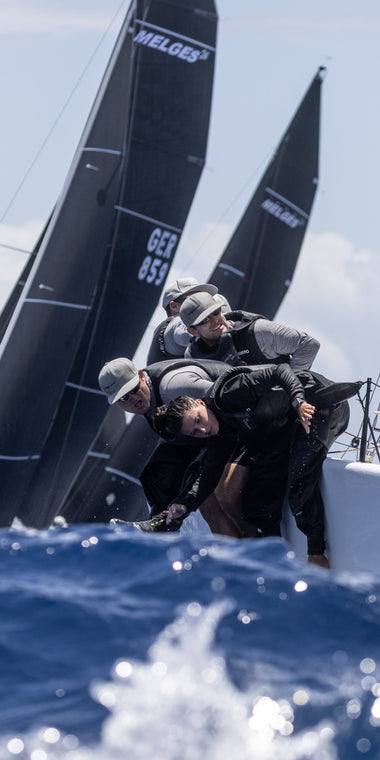MERLIN ROCKET TUNING GUIDE
Introduction
These are the current settings for the North Sail range of Merlin Rocket sails. This information will give the ability to pre-bend the mast when required and control the rig over the full range of conditions. With the ability of the modern Merlin to be able to make almost infinite adjustment whilst afloat this tuning guide will walk through setting up the standing rigging and then the control of the rig whilst sailing.
Spreader settings
The settings shown below for the Jackson/Chipstow mast are also a good starting point for all other masts. The focus being around 38mm of pre-bend, see below.
MERLIN ROCKET JACKSON/CHIPSTOW MAST
• Mast track to shroud wire – 365mm
• Tip of track to straight edge between shrouds – 140mm
• Shroud to shroud – 677mm
MERLIN ROCKET SELDEN SKINNY MAST
• Mast track to shroud wire – 365mm
• Tip of track to straight edge between shrouds – 137mm
• Shroud to shroud – 685mm
Standing Rigging Assumptions
The ‘jib hook’ position is crucial to maximize your mast rake.
• Jib halyard hook at ‘most upright’ setting – Shrouds and lowers loose, just able to get jib halyard onto hook (this is another crucial element, the shrouds should be adjusted so that there is only just enough slack to place the jib halyard on the hook)
.• Set the bow of the boat to perpendicular.
• The mast should now be perpendicular. Adjust the jib strop/halyard until this is achieved and this should be done before proceeding further.
Base Settings
Apply some rig tension 200kg (28-29 on Loose gauge PT-1) which equates to helm and crew sitting on the side deck and snugging up the leeward shroud plus a little bit.With the lowers fully released this should give you about 38mm of pre-bend at the spreaders. To measure this, the main halyard should be tied to the gooseneck and touching the mast at that point.
Note: Be careful that you don’t pull it so tight as to bend the mast further!Once this has been achieved pull on the lowers until the mast just starts to invert. The lowers need to have sufficient range to go from this base setting to totally free.Make a careful note of jib, shroud and lower settings. These are essential to enable easy replication when on the water.Apply more rig tension and possibly lowers as the wind increases to keep the leeward shroud snugged up. Rake when the top batten starts to invert or when the boom is off the centre line more than 50% of the time.

Fig. 1: shows the rig without lowers. You can see the little gauge at the spreaders which is used to measure the pre-bend, the thicker cloth ends 25mm from the mast track therefore 38mm pre-bend.

Fig 2: shows the slight inversion in the lower section (deck to spreaders) and the pre-bend reduces to 15 mm.
Basic principles
Why do we want all of this adjustment? The fundamental is to match the luff round to the mast bend and optimise the two. It also means that we can adjust the shape of the rig to maximize performance for the given conditions, flat mainsail in calm and windy, full in mid range to power up.



























